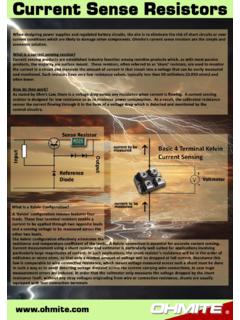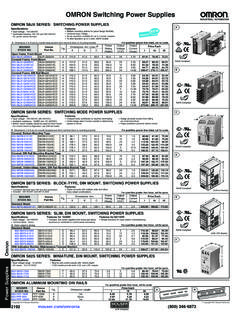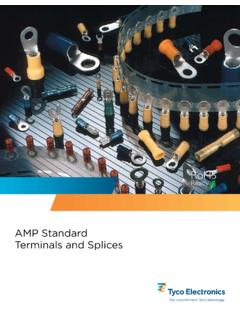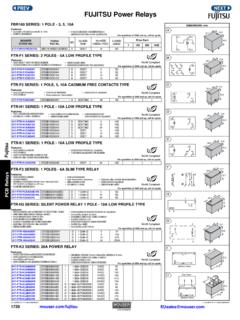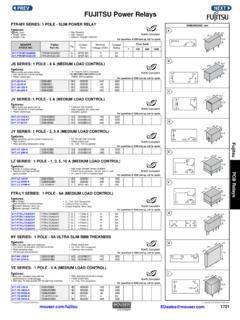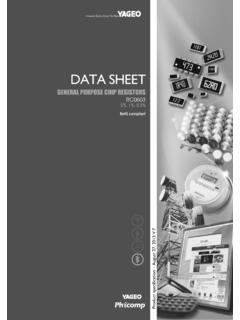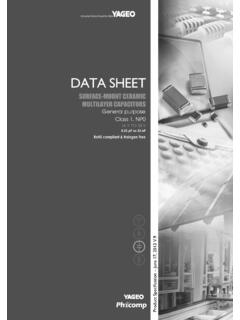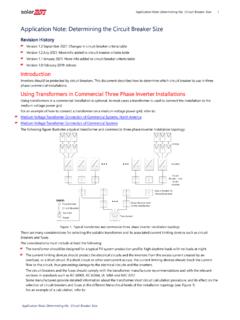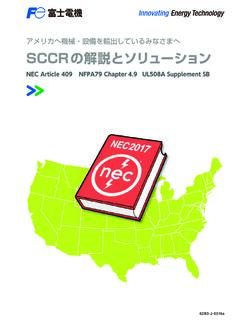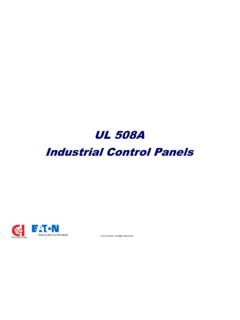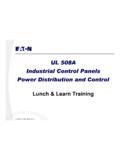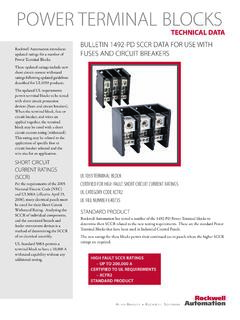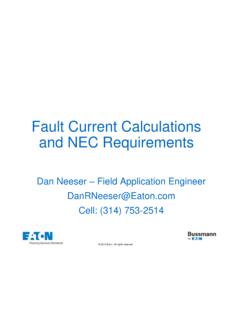Transcription of SHORT CIRCUIT CURRENT RATINGS - Mouser Electronics
1 SHORT CIRCUIT CURRENT RATINGSHow to Determine and Increase SHORT CIRCUIT CURRENT RATINGS for industrial control PanelsWHITE PAPER2 2019 Littelfuse, to Determine and Increase SHORT - CIRCUIT CURRENT RATINGS for industrial control PanelsIntroductionA SHORT - CIRCUIT CURRENT rating (SCCR)1 is the maximum CURRENT a device or system can safely withstand for a specified time (such as seconds), or until a specified fuse or CIRCUIT breaker opens and clears the CIRCUIT . SCCR is usually expressed in kiloamperes (kA). SCCR labeling requirements create a safe installation and help manufacturers, owners and managers meet OSHA regulations and NFPA codes and standards.
2 Both the NEC and OSHA forbid equipment from being located near any point where the available SHORT - CIRCUIT CURRENT is more than what the equipment can withstand. Available fault currents are increasing in industrial facilities due to a continuously increasing demand for electric power. When available fault currents at the equipment exceed the panel s SCCR, there can be catastrophic results. CURRENT -limiting fuses can optimize a panel to give it a strong competitive advantage over molded case CIRCUIT breakers (MCCB) so long as SCCR is considered in its design.
3 Most MCCBs do not provide adequate SCCRs. The most traditional way to increase a panel s low SCCR that is caused from an MCCB is to replace the MCCB with CURRENT -limiting fuses. But after making this improvement to the panel, how can you increase the panel s SCCR even further? Why Must industrial control panels Be Marked with Their SCCR?NEC Article requires industrial control panels (ICP) to be visibly marked with the panel s overall SCCR. NEC Article 409 requires an analysis of panels and facilities to be conducted for potential electrical hazards.
4 The marked SCCR must be based on either the SCCR of a listed and labeled assembly or on an SCCR that was established by an approved method. Overcurrent protective devices must also be marked with an interrupting rating or an ampere interrupting common misconception among equipment manufacturers is that the ampere interrupting capacity or the interrupting rating (IR) of the main CIRCUIT protection device is the same as the industrial control panel s (ICP) SCCR. This can confuse personnel about where the panel may be safely used. For example, before the introduction of NEC Article 409 in 2005, 1 SHORT - CIRCUIT CURRENT RATINGS were known as withstand RATINGS before the NEC first defined it in the 1999 a panel had a main feeder CIRCUIT protective device with an interrupting rating of 22 kA, then the manufacturer of an unapproved panel would also label their panel with an SCCR of 22 , each power component within the panel has a different SCCR or IR, many of which are likely to have a rating of 5 kA or less.
5 Therefore, if a 22-kA fault occurs, even if the main CIRCUIT protective device can safely interrupt the fault, one or more of the power components within the panel can still potentially catch on fire or violently NEC specifically requires SCCR markings for: Services (Article 230) industrial control panels (Article 409) Motors, Motor Circuits, and Controllers (Article 430) Air-Conditioning and Refrigerating Equipment (Article 440) Elevators, Dumbwaiters, Escalators, Moving Walks, Platform Lifts, and Stairway Chairlifts (Article 620) industrial Machinery (Article 670) Emergency Systems (Article 700) Legally Required Standby Systems (Article 701) Optional Standby Systems (Article 702) Critical Operations Power Systems (Article 708)
6 These markings allow installers and inspectors to compare fault CURRENT studies at the facility where the panels are intended to be installed to the SCCR of the control panel to minimize potential hazards in industrial or commercial safety and reliability, it is essential to compare accurate SCCR markings on equipment with the available fault currents on a regular 2019 Littelfuse, to Determine and Increase SHORT - CIRCUIT CURRENT RATINGS for industrial control PanelsWhat is a CURRENT -Limiting Overcurrent Protective Device? CURRENT -limiting overcurrent protective devices, as defined by Article of the NEC, reduce the CURRENT flowing in a faulted CIRCUIT to a magnitude that is substantially less than what would otherwise be obtained if the device were replaced with a solid conductor with a comparable impedance.
7 When operating in their CURRENT -limiting range, these devices can clear a SHORT CIRCUIT CURRENT in less than milliseconds, which is less than one half of an electrical ac cycle (see Figure 1). CURRENT -limiting overcurrent protective devices must interrupt currents in their CURRENT -limiting range to be Does CURRENT Limitation Increase SCCRs? CURRENT limitation increases SCCRs because it reduces the destructive thermal energy. Figure 1 shows the maximum instantaneous peak CURRENT (Ipeak) during the first half cycle after the initiation of a fault.
8 The gray area represents what the Ipeak will be without the use of CURRENT -limiting fuses, while the green area depicts the Ipeak when CURRENT -limiting fuses are on the power factor and when the fault occurs, the maximum possible Ipeak without CURRENT limitation can be as high as times the available rms fault CURRENT when the fault occurs. However, when CURRENT -limiting fuses are used, the maximum Ipeak is only a small fraction of what the potential flow would otherwise be. The area under the curve represents the I t let-through energy of the fuse.
9 The lower the I t, the lower the potentially destructive thermal energy will be that passes through the CIRCUIT when it is 1. Maximum instantaneous peak CURRENT during first 1/2 cycle of a fault with CURRENT -limiting fuses versus noncurrent-limiting : Total clearing I2t = Melting I2t + Arcing I2tPoint at which a fault occursArc is extinguishedMaximum peak-let through CURRENT with CURRENT -limiting fusesFuse elements meltArcing energy (l2t)Maximum peak-let through CURRENT with noncurrent-limiting fuses.(Peak value can be as high as times the available rms fault CURRENT .)
10 Melting energy (l2t)MeltingtimeArcingtimeFuse total clearing time(less than a cycle)4 2019 Littelfuse, to Determine and Increase SHORT - CIRCUIT CURRENT RATINGS for industrial control PanelsInterrupting RATINGS for Overcurrent Protective DevicesAlthough fuses and CIRCUIT breakers are tested using different methods, a fuse s interrupting rating (as well as the AIC of a CIRCUIT breaker) is considered to be the same as its SCCR. NEC Article says that equipment intended to interrupt CURRENT at fault levels shall have an interrupting rating at nominal CIRCUIT voltage at least equal to the CURRENT that is available at the line terminals of the equipment.
